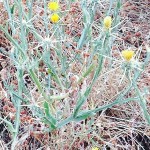While Idaho County is one of the most beautiful and diverse regions in Idaho, it’s assets also provide an environment very conducive to exotic plant growth. We have the largest land area of any county in the state (5.4 million acres), allowing plenty of space to grow invaders. We have precipitation variation from less than 10 inches per year to over 60 inches in some areas of the county. We also have elevational differences from over 8,000 feet to under 1,500 feet above sea level. And, our soils vary from sand to clay.
This spectacular space and environmental diversity allows us the ability to grow almost any weed in the world.
In addition to the ecological environmental assets for weed growth, Idaho County has become an increasingly important destination for travelers and recreationists. This influx of visitors is often an important introduction mechanism for invading alien weed species.¹
Our Idaho County Weed Management teams handle eradication methods of noxious weeds in the grazing lands of the Salmon River Canyons and other public lands in the area. All private property owners should establish efforts to eradicate and prevent the spread of noxious weeds on private property. Its through the combined efforts of all Idaho County citizens, that noxious weed eradication will benefit everyone, for sustainable use of our pasture, grass and range lands.
It’s best to diligently manage these noxious weeds through methods of eradication that vary from hand pull removal of the weed, use of sprays like Roundup, using goats to ingest the weeds, or in working with bio control agents such as weevils, to attempt to reduce and eradicate the growth and spread of the noxious weeds.
Yellow Star Thistle
Bees may be enamored by Yellow Star Thistle, but horses are not.
In particular, if horses ingest star thistle, the results can be fatal. ‘Chewing disease’ results when horses eat yellow starthistle. This disease affects their nervous system and is usually fatal.
Cows, goats and sheep can eat star thistle in the early spring before spines develop and can be effective in reducing seed production.
Star Thistle has an advantage over native plants because it matures earlier in the season. Its roots rapidly grow as far as 3 feet down into the soil stealing water and nutrients that the native plants need to survive the hot summer. Yellow star thistle degrades wildlife habitat and chokes out desirable species with ruthless indifference.
WHERE DID IT COME FROM?
It is popularly thought that Yellow Star Thistle was introduced to America during the Gold Rush in California in the early to mid 1800’s. Alfalfa hay imported from Europe would have contained the seeds which is how the yellow star thistle came to be proliferated in the west.
ERADICATION
Effective means of eradication require diligent attention over several years in order to impact the reduction of the spread of seeds. On smaller properties, hand removal of the plant and root can be effective, but diligence is key. Continued attention to new growth of star thistle is a must to keep the problem from resurfacing. The seeds can remain viable for up to 10 to 12 years.
Herbicide, like Round Up, can be applied in the spring while the plant is in its rosette stage, to kill the plant before it blooms and releases seeds.
Yellow Star Thistle seeds are flame resistant, so burning the Yellow Star Thistle plant is not an effective means of removal, and can result in a larger infestation in following years.
Experiments with bio control agent methods are being conducted as potential alternatives to spraying. Plant science experts are working with insects, releasing small weevils among the stem plants. The weevils lay eggs in the stems which in turn, leads to a failure of the plant itself. However the introduction of weevils are not effective when the plant has bloomed and developed seed heads. The release of seeds is still the problem.
The video below provides insight on the eradication methods used by the Idaho County Extension office – for weed management along the Salmon River Basin.
For more information about weed management on your property, contact the Idaho County Extension office:
Idaho County Extension Office – Weed Management
320 West Main Street, Rm 3
Grangeville, Idaho 83530
208-983-2667
The Idaho County Weed Management office is charged with providing solutions for the weeds we have, as well as for prevention practices for the weeds that are being introduced. One of the solutions to these challenges has been the formation of Coordinated Weed Management Areas in the county.


